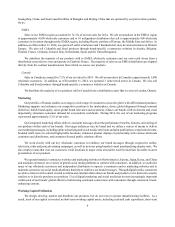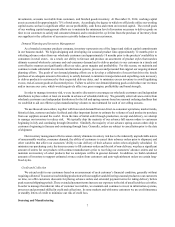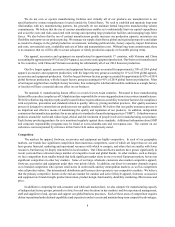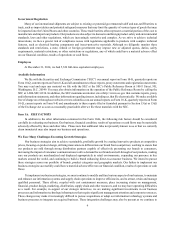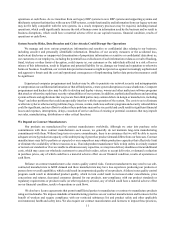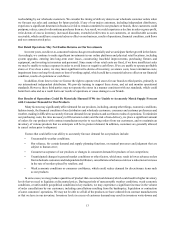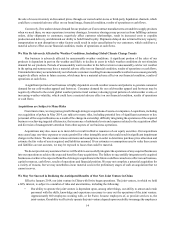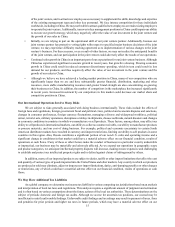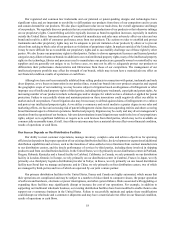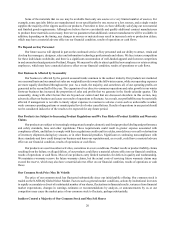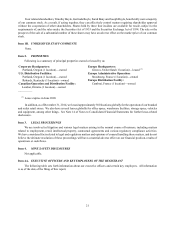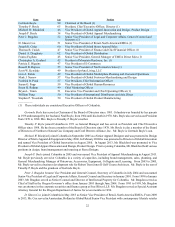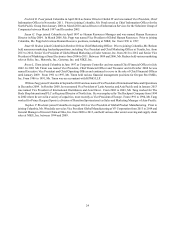Columbia Sportswear 2014 Annual Report Download - page 20
Download and view the complete annual report
Please find page 20 of the 2014 Columbia Sportswear annual report below. You can navigate through the pages in the report by either clicking on the pages listed below, or by using the keyword search tool below to find specific information within the annual report.16
financial condition, results of operations or cash flows. Changes in tax law or our interpretation of tax laws and the resolution
of current and future tax audits could significantly affect the amounts provided for income taxes in our consolidated financial
statements.
We earn a significant amount of our operating income from outside the United States, and any repatriation of funds
currently held in foreign jurisdictions may result in higher effective tax rates for us. If we encounter a significant need for
liquidity domestically or at a particular location that we cannot fulfill through borrowings, equity offerings or other internal
or external sources, we may experience unfavorable tax and earnings consequences as a result of cash transfers. These
adverse consequences would occur, for example, if the transfer of cash into the United States is taxed and no offsetting
foreign tax credit is available to offset the U.S. tax liability, resulting in lower earnings. Furthermore, foreign exchange
ceilings imposed by local governments and the sometimes lengthy approval processes that foreign governments require for
international cash transfers may delay or otherwise limit our internal cash transfers from time to time.
We Operate in Very Competitive Markets
The markets for apparel, footwear, accessories and equipment are highly competitive, as are the markets for our
licensed products. In each of our geographic markets, we face significant competition from global and regional branded
apparel, footwear, accessories and equipment companies, including competition from companies with significantly greater
resources than ours.
Retailers who are our customers often pose our most significant competitive threat by designing and marketing apparel,
footwear, equipment and accessories under their own private labels. For example, in the United States and Europe, several
of our largest customers have developed significant private label brands during the past decade that compete directly with
our products. These retailers have assumed an increasing degree of inventory risk in their private label products and, as a
result, may first cancel advance orders with us in order to manage their own inventory levels downward during periods of
unseasonable weather or weak economic cycles. As our direct-to-consumer businesses grow, we also experience direct
competition from retailers who are our customers, some of which primarily operate e-commerce operations and employ
aggressive pricing strategies. We also compete with other companies for the production capacity of contract manufacturers
from which we source our products and for import capacity. Many of our competitors are significantly larger than we are
and have substantially greater financial, distribution, marketing and other resources, more stable manufacturing resources
and greater brand strength than we have. In addition, when our competitors combine operations through mergers, acquisitions
or other transactions, their competitive strengths may increase.
Increased competition may result in reduced access to production capacity, challenges in obtaining favorable locations
for our retail stores, reductions in display areas in retail locations, reductions in sales, or reductions in our profit margins,
any of which may have a material adverse effect on our financial condition, results of operations or cash flows.
We May Be Adversely Affected by the Financial Health of our Customers
In recent periods, sluggish economies and consumer uncertainty regarding future economic prospects in our key
markets had an adverse effect on the financial health of our customers, some of whom filed or may file for protection under
bankruptcy laws, which may in turn have a material adverse effect on our results of operations and financial condition. We
extend credit to our customers based on an assessment of the customer’s financial condition, generally without requiring
collateral. To assist in the scheduling of production and the shipping of seasonal products, we offer customers discounts for
placing advance orders and extended payment terms for taking delivery before the peak shipping season. These extended
payment terms increase our exposure to the risk of uncollectable receivables. In addition, we face increased risk of order
reduction or cancellation or reduced availability of credit insurance coverage when dealing with financially ailing retailers
or retailers struggling with economic uncertainty. Some of our significant wholesale customers and distributors have
liquidated or reorganized, while others have had financial difficulties in the past or have experienced tightened credit markets
and sales declines and reduced profitability, which in turn has had an adverse effect on our business. We may reduce our
level of business with customers and distributors experiencing financial difficulties and may not be able to replace that
business with other customers, which could have a material adverse effect on our financial condition, results of operations
or cash flows.
We May Be Adversely Affected by Global Credit Market Conditions


